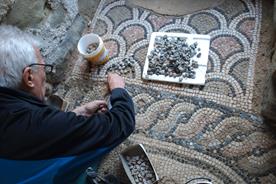
Since its discovery in 1971, the Baptistry in the Episcopal basilica and its mosaic pavement with the illustration of the 41 Psalm of David dated in the middle of the 5th century became the most recognizable symbol of the archaeological site Stobi. The first conservation activities were undertaken soon after it was uncovered, according to the current knowledge and practice. Since then, except for regular maintenance and preventive protection, there were no serious conservation activities undertaken. During this long period, the atmospheric influence and humidity caused serious deterioration of the lime mortar of the bedding causing detachment of the tesserae, depressions and deviations of the mosaic surface. In addition, the tesserae, especially those made of black stone are disintegrated. Therefore, the conservation activities were urgent and necessary in order to reestablish the structural stability of the mosaic.
The project for conservation and restoration of the famous peacock mosaic in the Baptistry was prepared couple of years ago. The actual work has started in May 2017, thanks to the Ambassadors Fund for Cultural Preservation in 2016. Six experts, senior and younger conservators are involved in the project, conducted by Vladimir Simeonov, licensed mosaic conservator.
After the preparation of the working area and procurement of the necessary tools and conservation materials, work have started according to the accepted combined method of conservation in situ and partial lifting of the most damaged parts.
First, the mosaic was cleaned of dirt and dust. After the detail examination, the most damaged parts for lifting are marked. The senior conservator Jani Antoniev from the National Conservation Centre started with careful replacement of the dark gray and black tesserae (dray retouch).
The other members of the team, worked on replacement of the old lacunae filled with cement during the conservation of the mosaic in the 1970’s. Lacunae are damaged parts of the mosaic where the tesserae are completely missing, as it was discovered in the 1971. It is common practise in mosaic conservation to fill the lacunae with the same mortar as the bedding of the tesserae, although in the past the cement was also frequently used for that purpose. Since in the modern practise advocates the usage of lime-based mortars close to the original hydraulic mortar. The whole process is carefully documented.
To see the gallery click the following link: https://www.facebook.com/pg/Muni.Stobi/photos/?tab=album&album_id=1765433360187078